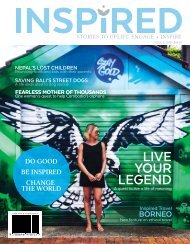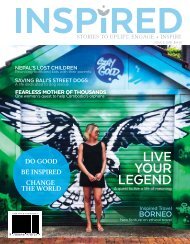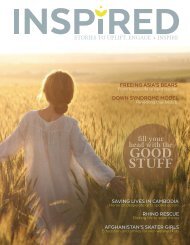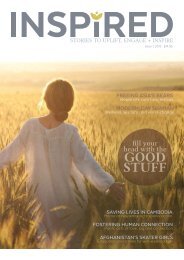Inspired Magazine
Profiling world changers, eco-warriors, peace makers
Profiling world changers, eco-warriors, peace makers
You also want an ePaper? Increase the reach of your titles
YUMPU automatically turns print PDFs into web optimized ePapers that Google loves.
It’s 1998 and Carina Hoang has returned to the<br />
place of her nightmares. She thrashes through<br />
the jungle, the guide hacking through the fortress<br />
of trees with a machete to reveal long-forgotten<br />
graves. These overgrown tombs mark the bodies<br />
of Vietnamese refugees who fled in their hundreds<br />
of thousands after the Vietnam War. Eventually<br />
she finds it – the grave of her cousin who died here<br />
nearly 20 years before.<br />
News of the find spreads. Pleas from other<br />
Vietnamese families trickle in. Can Carina help find<br />
the graves of their loved ones?<br />
Now, each year, Carina returns to tiny, remote<br />
and little-known Indonesian isles to search for<br />
more graves. She’s made seven trips, discovered<br />
more than 100 graves and taken 20 families to the<br />
final resting place of their loved ones. She does it<br />
out of her own pocket, in her own time. Why does<br />
she return to this place of the dead? Because she<br />
was very nearly one of them.<br />
FEAR<br />
Rewind to 1975 and 12-year-old Carina’s life had<br />
turned upside down. Her dad, a former police chief<br />
in South Vietnam, had disappeared. Some people<br />
whispered that he’d killed himself. Others said the<br />
communists had captured or killed him. Still others<br />
said he’d escaped. His military involvement during<br />
the war meant he was a wanted man by the<br />
communist government.<br />
Panicked, Carina’s mum destroyed all evidence<br />
of their former lives. She amassed everything –<br />
marriage and birth certificates, photos, papers<br />
and burned them. She gathered all her treasures,<br />
all the gold this once-comfortable family had<br />
accumulated, and hid it in jars and toys.<br />
They lived in fear that each knock on the door<br />
was a communist coming to take them to a South<br />
Vietnamese ‘re-education camp’ for political<br />
prisoners. They knew there’d be no trial, no<br />
sentence.<br />
They were forbidden from working or passing<br />
their school tests, yet selling on the black market<br />
was illegal. They knew hundreds of thousands<br />
of city people were being rounded up by the<br />
truckload and dumped in ‘new economic zones’ –<br />
uncultivated fields with no shelter, no food – and<br />
told to forge a life for themselves.<br />
Then, in 1978, the war with Cambodia broke out.<br />
Carina’s mum knew her children would be drafted<br />
as soon as they reached 16 years. Carina’s mum<br />
first organised for Carina’s older sister and younger<br />
brother to escape – they fled for safety in Malaysia<br />
aboard a small fishing boat where they hid in a<br />
hull packed with ice.<br />
Several months later it was Carina’s turn. She was<br />
15 years old and would have to take her 11-year-old<br />
brother and 10-year-old sister with her. Carina’s<br />
mum would remain behind with her two youngest<br />
children.<br />
ESCAPE ATTEMPTS<br />
First, Carina attempted to flee on the same<br />
boat on which her siblings had escaped earlier,<br />
but someone tipped off the police and the boat<br />
left without Carina. Next Carina and her younger<br />
siblings joined a group of escapees who fled via<br />
train, on foot and in a truck, dodging military<br />
checkpoints, to a secret beach where they waited<br />
for small taxi boats to ferry them to a bigger<br />
vessel. But when the taxi boat did not return after<br />
a second group had been transported they knew<br />
something had gone wrong. They fled into the<br />
forest but police caught most of them. Carina and<br />
her siblings were among the few who escaped.<br />
By January 1979, they were ready to try again.<br />
But they’d been lied to – after handing over her<br />
mother’s gold to the people smugglers, Carina<br />
discovered the boat was being rebuilt and not<br />
ready for the journey. Carina was stuck hiding in<br />
the country, hundreds of kilometres away from her<br />
family.<br />
“I could not contact my mum, I could not go<br />
home, could not leave the house, and my mum<br />
did not know where to find me,” she says. “Almost<br />
daily, I saw lines of escapees who were led by<br />
policemen, walked by the house with their hands<br />
tied behind their back. I remembered thinking it<br />
would only be a matter of time [before I was] one<br />
of them.”<br />
A month later, Carina was returned to her<br />
mother, the gold replaced with nothing but a set of<br />
earrings.<br />
ESCAPE<br />
Ever resourceful, Carina’s increasingly desperate<br />
mother wrangled another escape opportunity.<br />
Carina and her siblings would pose as Chinese<br />
Vietnamese who were being exiled from the<br />
country. In May 1979, a by then 16-year-old Carina<br />
and her younger brother and sister boarded a<br />
25-by-five-metre wooden boat, along with 373<br />
others, including 75 children. The boat operators<br />
forced the refugees into the bowels of the boat<br />
where they’d remain for seven days.<br />
The first night a storm struck and the terrified<br />
passengers became violently ill. With no room to<br />
lie down, it wasn’t long before they were covered in<br />
vomit, urine and faeces.<br />
After recovering from the storm they were<br />
attacked by Thai pirates. They’d heard stories<br />
of such attacks – babies thrown overboard,<br />
men murdered, women raped – so the women<br />
and children rushed to cover themselves with<br />
excrement in a bid to deter would-be attackers<br />
from approaching them.<br />
By the third day the boat approached Malaysia<br />
and spirits soared – it seemed freedom was in<br />
sight. But Malaysia had just introduced a ‘push<br />
back policy’ towards boat people. They’d been<br />
instructed to shoot to kill to deter the refugee<br />
Opposite page, top<br />
Carina at a grave of a<br />
Vietnamese refugee on<br />
Kuku Island, Indonesia<br />
in 2010.<br />
Opposite page,<br />
bottom Carina’s<br />
refugee ID photo on<br />
Kuku Island in 1979.<br />
CARINA HOANG<br />
53












